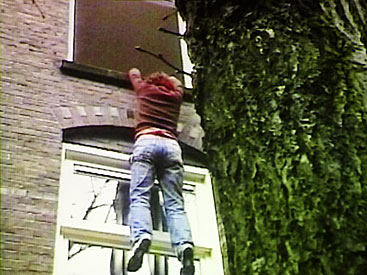
Born in 1969 in Kristinehamn (SE)
Lives and works in Amsterdam (NL)

2000
Video, colour, sound
Durée : 2'46"
Year of Purchase: 2000
Pia Wergius belongs to that young generation of artists who are upsetting film-making principles and seeking a degree of autonomy for the medium, notably by introducing a different relationship to notions of time and space. The allegorical evocation of the double is one of the key themes of his work. Like other contemporary female artists from Northern Europe (Eija-Liisa Ahtila, Ann-Sofi Sidén…), Pia Wergius explores the metamorphosis of identities, playing on our perception of time – an anachronistic, seemingly suspended time.
Sketch for Angels plunges us into the dramatic tension of a cliffhanger situation, that of the character being filmed. The camera slides along the ceiling of a sitting-room until it comes to the window. The window is open and we see a red-haired girl hanging from the windowsill of a typical house in Amsterdam1. She does not fall, she is still holding onto something – to a kind of magical weightlessness. At this moment of suspense when consciousness flips over into a different way of relating to the world, we do not know whether or not she has considered the possibility of her falling. What we do know is that she is in danger. This danger for her may be a matter of a mere instant or hours: a way of testing life’s dilemma, her life’s or the world’s. One of the many ways of ‘reaching the depths’, perhaps, as if to better assess the void. Here any kind of rationality must be ruled out in discovering a weightless, endless world, between the final fall and rescue! The woman’s vulnerable state is symbolized in the little song that seems to buck up her spirits at this break-off point on the edge of the precipice.
The change-over performed by this artist belongs to the ‘I is another’ of Rimbaud which seems to have become a truism in today’s cultural rhetoric. ‘This multiplying of the self of course fascinates, but it is also sometimes disconcerting as it evokes in us all the potentially disturbing consequences of the loss of a full, focused subject; a disturbance of the boundary between fiction and reality, a disturbance of the identity, the loss of limits’2.
A man walks by, the hair moves, the car is parked, the sky seems to have cleared, although still overcast.
Cécile Bourne
1 Hook with an axle hung from the roof timber, still used today for furniture removals.
2 ‘Le Golem de l’écriture : de l’Autofiction au Cybersoi’, Montreal, XYZ, 1997.